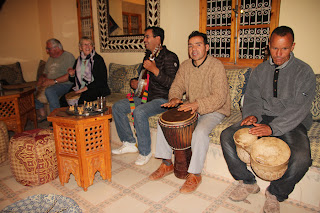 |
| (Click on to enlarge, back arrow in top left to return) |
Leaving
Chefchaouen for Fez we thought we'd try some small roads on the map. The one we
tried led us into beautiful countryside where there was a mule for every man,
woman and child! The people we passed were friendly, smiling and waving. Except
one teenage girl. We slowed down. I had the idea to offer her a lift (we'd
picked up a few people during our car journey). She stopped dead in her tracks
and quickly turned back the way she'd come. She looked frightened. I felt
stupid. Of course, a girl or woman could never get in a car with a stranger.

We saw several fields that were separated by cactus hedges - many with agave. But no tequila!

We saw several fields that were separated by cactus hedges - many with agave. But no tequila!
The country road led back to the 'main' road about 20 km from Fez. Then just before a right curve in the road we were directed off the road onto another country road. Lots of Arabic explanation! We went through stunning hilly farmland. Olive trees planted on steep slopes. Grazing livestock. And mules.
When we
returned to the main road we were about 25 km from Fez! The reason for the
detour became apparent. The road continued through steep farmland and we passed
three or four spots where the road was crumbling away downhill. No markers or
warning at all. We came around a curve and the two lanes became one and the
downhill lane was a sloping hole! It would have been deadly after dark.
Fez is very
impressive on first sight. It is built in a hilly area and the two towns - the
ancient medina and la ville nouvelle - are completely separate. There's lots of
green space between them and the countryside is visible from both.
I find
parts of the medina claustrophobic and dirty. Most pathways are about four feet
wide. When a mule or a man bearing an oversized load comes through the only
thing to do is flatten yourself against the wall. Lots of mule and horse dung
and rotting vegetables. Mules up close give off a powerful odour! Ian still
sees beautiful things.
 |
| A 13th century madrasa's (Islamic school) new "pupils" |
 |
| A rare find: Pizza & beer! |
 |
| The drug that keeps us going |
Ian writes: In Morocco, like everywhere, you can finding lodging from
dingy hovels to Five Star
monotony. We opted for riads, traditional townhouses with
rooms facing onto an inner courtyard in the heart of the medina. Occasionally,
we stayed at kasbahs, forts or
citadels renovated into small hotels,
While often lacking heat and enough light
bulbs, they are full of charm and character and I love them. Some are truly gems when the owner has enough
funds and style to bring the old brick and tile to life. A few nights, we swapped lodging for
publicity photos. Here’s a
selection…
 |
| Riad Doha in Fes |







































.jpg)

.jpg)
.jpg)
.jpg)
